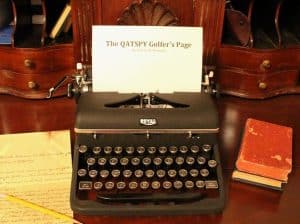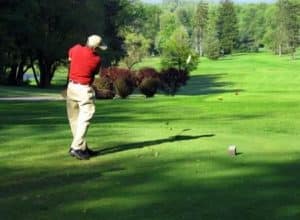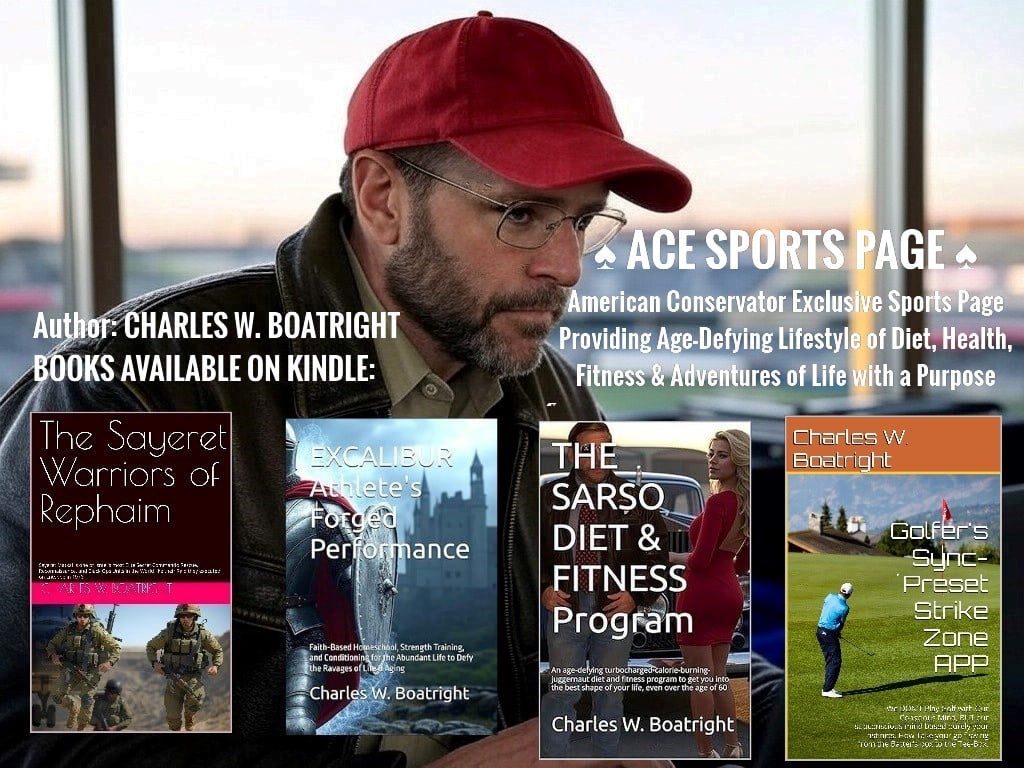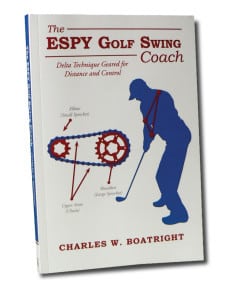THE QATSPY GOLFER’S PAGE
By: Charles W. Boatright
A pedigree of a Golf Coach, a grandfather
A pedigree of a golf coach, a grandfather, that left his passion for the ART of golf and life to his grandson. The ART of golf is the only means to describe how Hemingway (Hemi) Quinn Boatright, my grandfather, played and taught golf with such grace that allow young and old alike to grasp the fundamentals and techniques of the golf swing. My golf coach allowed the golfer to actually become an artist in expressing their golf swing to create a photo finish that only a Michelangelo could capture in his sculptures. You always know that you have hit a great golf shot when you can pose in a photo finish to watch art in motion.
There aren’t many days when I prepare to go to my home golf course, Lake Caroline in Madison, Mississippi, that I don’t reflect on an earlier time in my life that, in one way, seems like another generation of a golf coach. But in the same moment, it seems like only a couple of months that I had a conversation with my golf coach where his voice is still vivid like I just got off the phone with him.
The Old Red and White 1969 Ford Bronco
I remember as young teenager every Saturday gathering up my golf coach golf clubs from the barn and loading it into my granddad’s red and white 1969 Ford Bronco and head out to the North Hills Golf Course in North Little Rock, Arkansas. I especially recall those brisk, cool fall mornings where the foliage was painted in a brilliant spectrum of orange, yellow, and red colors against the foothills of the Ozarks. The North Hills Golf Course was the only golf course in Arkansas that was designed by Robert Trent Jones, Sr., with its classic layout. What a great place to learn the ART of golf on such a classic golf course.
The Red Book of my Golf Coach, his ART of Golf

My granddad, in his later years, did not have the athleticism that he once possess in his mid-forties, when he held a single-digit handicap. But he had a classic, old- school golf swing with the iconic raising of his left heel off the ground during his backswing, like a baseball-type swing. His golf swing seemed to flow like art with a smooth rhythm, of nice-and-easy. It is the only golf swing that I ever was taught and documented during sermon- like instruction lessons. Included in my three Xerox boxes was his red books of data my golf coach collected on the golf swing, I still have the Red Book with instructions and diagrams of the golf swing that I learned from my grandfather, Hemi Q. Boatright, who is shown here in 1946 at the North Hills Golf Course.
The ART of Golf that my golf coach taught was based on Approach, Routine, and Technique.
Golf Passed Down Through the Boatright Generations
It wasn’t until later years after my grandfather’s passing at a family reunion that I actually learned how this fascinating game of golf was passed down through four generations starting with Valentine Boatright (2a) and his brother Ambrose (2b). In the photograph below, is a family photograph of Daniel Boatright’s (1), 6X Grandfather, family featuring these two brothers, Valentine (2a) and Ambrose (2b) Boatright. What makes this photograph interesting is the common link between two branches of the Boatright family, my grandfather’s with Valentine and that of Purvis James (P.J.) Boatwright, Sr. with Ambrose. An interested piece of history is with the family of P.J. Sr son, P.J. Boatwright Jr., a past executive director of the United States Golf Association. P.J. Boatwright Jr. played with Ben Hogan in the 1950 U.S. Open. Also you notice the two ways to spell Boatright with a ‘W’ and without the ‘W’. I guess the family that went west dropped the “W”. My grandfather finally settled in Arkansas in Madison County where he had a distant cousin, Chesley Boatright, that was killed in The Huntsville Massacre on January 10, 1863 by Union Soldiers.

A Golf coach Technique and Golf Swing that has Stood the Test of Time
When I say I have a golf swing that I learned from my golf coach that has stood the test of time, I’m not exaggerating, but there was a generation skip with my 3x Grandfather, Egbert Garnett Boatright (4), who was more of a banker than he was a golfer. Golf had not yet become associated with the business world. But the serious golfer was Jonas Boatright (3) who also had a mercantile business and was his own golf coach. Golf in my family had its generation skipped and was picked up by my grandfather from his grandfather, Jonas Boatright (3). The reason I believe for this generation skip is due to the limited time that fathers had, due in part to being preoccupied with their professions and businesses. So, the grandfathers usually living in the vicinity would be the athletic director for their grand kids golf coach. This was the same case in my situation, My grandfather was my golf coach.


NOTE: The numbers by the names of the family member corresponds to their photograph in the pictures.


My grandfather, Hemi Q. Boatright, featured here, above left, while on vacation in 1927 at Yellowstone National Park, was a Depot agent in Leslie, Arkansas and worked on his golf game in his spare time, in a field next to the train Depot featured below taken in 2004. Leslie is located in the heart of the Ozarks Mountains, just off Hwy. 65, not too far from the Buffalo River National Park, a great spot for canoeing and viewing wonderful cliffs and vistas along the river. This was where I learned the ART of golf from my golf coach.

Railroad Depot at Leslie, Arkansas just of U.S. Hwy 65
Even today after retiring in 2014, I still strictly use lessons from my grandfather’s my golf coach, Hemi Q. Boatright The Great Qatspy, from his Red Book shown below left along with his typewriter that he used while a Depot Agent. His lessons that are based off motor-skills and muscle memory in the baseball-type swing, I still use his golf coaching techniques from tee-to-green even today when I head out to the golf course, (illustrated in the photo below right where I’m at Dancing Rabbit Golf Course in Philadelphia, MS.


I thought one day I would take time and transcribe his coaching notes, techniques, and mechanics into a book for my personal use. I decided to start this journey in 2002 with an outline. That outline became a manuscript based on my grandfather’s coaching techniques, combined with seven years of my own research and development I did after I attended Tulane University for Kinesiology and Ergonomics. His lessons and biomechanics I learned, are compiled in my book, The ESPY Golf Swing Coach. Much of this information noted in my book were notes taken from my grandfather’s lessons, on and off the golf course.
But what was equally as special was a happenchance meeting and impromptu interview I had with a Vietnam War Veteran of Hattiesburg, Mississippi, who was held as a P.O.W. in the Hanoi Hilton. This meeting helped me verify the mental techniques of my grandfather’s Red Book and my book. Colonel George Robert Hall spent over seven years at the infamous Hanoi prison, where he mentally played his golf game every day in his seven-and-a-half foot square cell to survive his captivity. He called his cell his Pebble Beach.
Before he was shot down in September of 1965, Col. Hall had a handicap of four. Six weeks after his release in February of 1973, he was invited to play in The Greater New Orleans Pro-Am Open, where Jack Nicklaus won the tournament that year. Colonel Hall shot his handicap, with a score of 76.
I have included short section of my interview with Colonel Hall below:
Question No. 1
BOATRIGHT: “What did you use as a golf club?”
COL. HALL: “I used my left thumb to represent the handle of the club, and placed my right hand around the left thumb. This also gave me the opportunity to maintain the correct grip pressure on the handle of the club and preset my wrists, as I did when I played golf on a regular basis.”
Question No. 2
BOATRIGHT: “What was the key component in your golf swing to give you the most realistic feel, since you did not have a golf club or experience the results of your golf shots?”
COL. HALL: “Everything had to be associated with my hands and wrists. I could not think about the floor as the ground or as my reference point. If I could preset my wrists in the proper sequence, based on how I played golf prior to my deployment to Vietnam and my capture, I could feel how the forearms and wrists reacted during my golf swing.”
Question No. 3
BOATRIGHT: “So, your point of reference was waist level at your hands?
COL. HALL: “Yes, to be more specific, my thumbs. I kept all the impact, essentially, at the level of my hands, similar to how a baseball player uses a bat to take batting practice.”
Question No. 4
BOATRIGHT: “I have centered my muscle memory development on two points, the base of my wristbands and the base of the thumb and palm, called the Hypothenar. Did you center on keying in on a particular muscle to execute your golf shot?”
COL. HALL: “Yes, I read about how Ben Hogan described his Hypothenar as being a key part of his golf swing to pronate and supinate his wrists and hands to open and close his clubface.”
COL. HALL’S Question: “How did you determine the significance of the Hypothenar in the golf swing?”
BOATRIGHT: “In Kinesiology, my professor, Dr. Bunch, stressed the importance of two muscles used in the baseball-type swing that could help linemen reduce injuries to the wrists. These were the Brachio-Radialis muscle and the thenars, particularly the Hypothenar. Both are unique in that the Brachio-Radialis muscle can both pronate and supinate, and the thenars are the strongest and most dexterous muscles in the hand.”
Question No. 5
BOATRIGHT: “Have you ever read or seen a video series by Mr. Eddie Merrins, aka The Little Pro, where he focused on swinging the handle of the club and not the club, similar to how you use your left thumb to represent the handle of the club and the right thumb to represent the clubface?”
COL. HALL: “No I haven’t, but that is interesting how you use your right thumbs to represent the clubface. The more I think about it, that goes along with the same technique of having a strong or weak grip by the placement of the right thumb. I was doing the same thing, but I did not consciously go to that level of detail, like you are doing.”
BOATRIGHT: “If you think about the difference between the weak and the strong grip, most generally, it entails the placement of the right thumb on the handle of the club. That was the reason I think swinging the handle of the club is an important part to improving the golfer’s game and swing that you proved.”
Question No. 6
BOATRIGHT: “So you interface with your golf swing by moving the golf ball from the ground, up to your hands also?”
COL. HALL: “I found out by moving the ball from the floor to my thumb that you have a better point of reference to how you’re executing the golf shot, and you have a better chance of making a realistic and solid golf shot.”
Boatright: “You definitely proved that during the Pro-Am.”
Question No. 7
BOATRIGHT: “I’ve got to ask this question. What were your guards thinking when they saw you making a virtual golf swing with your hands, arms, and shoulders?”
COL. HALL: “Probably, they were thinking that they have finally broken me, and I lost all touch with reality.”
BOATRIGHT: “If I had been your guard in a country where golf wasn’t a popular sport, or even heard of, I would think the same thing. That you lost your mind!”
By: QATSPY GOLF Approach
Charles W. Boatright
Madison, MS
1-888-514-1228
www.espygolfapp.com
The ESPY Golf Swing Coach– Price for Paperback $15.75 and E-Book $8.99, Hardback is also available on my website: www.espygolfapp.com/store. OR your local bookstore and also:
Lulu Publishing: The ESPY Golf Swing Coach, Charles W. Boatright
Amazon.com
Barnes & Noble.com
Check out my full library of BLOGS @ www.espygolfapp.com/blog or purchase your copy of “The ESPY Golf Swing Coach” @ www.espygolfapp.com/store.
Facebook – The QATSPY Golf Approach
Twitter – @cwboatright
Google+ – ESPY Golf Swing Coach
YouTube – ESPY Golf Swing Coach

Charles W. Boatright
Author of The ESPY Golf Swing Coach
A self coaching technique allows the golfer to take their baseball swing from the batter’s box to the tee box with POWER, SPEED, CONFIDENCE, and CONSISTENCY!
Like learning to ride a bicycle, once you learn WHY, you don’t forget HOW!
YouTube Videos:
https://youtu.be/ZGVNrIw_wlo (Cam & Cam-over elements)
https://youtu.be/K2FDHZ3AX9w (Figuring your proper swing plane)
https://youtu.be/TO82PMO6G8M (Developing muscle memory)
Two decisions that you can make for yourself and your kids are to get a copy of my book and place the book and a golf club into their hands. You will never look back, but only forward. You will not miss with this for yourself and/or your kids.
A Recommendation for your Golf Game:
I would like to recommend a wonderful radio program that I regularly listen to on my I-Heart Radio app on KARN 102.9 FM station, out of Little Rock, AR. They air a golf show called “Arkansas Fairways and Greens,” at 7:00 AM CT each Saturday morning, hosted by Bob Steel and Jay Fox. Bob occasionally has on his show a guest named Shawn Humphries, a Professional Golf Instructor from Dallas, Texas. One thing that Mr. Humphries stresses is the mental part of golf, not focusing on the results but the process.
Until next time– Be Synched, Tee-to-Green, with The ESPY Golf Swing!


